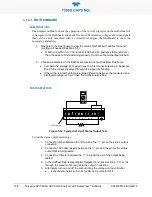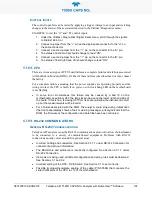
083730510A DCN8172
Teledyne API T500U CAPS NO
2
Analyzer with NumaView™ Software
113
6.
PRINCIPLES OF OPERATION
The Cavity Attenuated Phase Shift (CAPS) NO
2
monitor operates as an optical absorption
spectrometer that yields both reliable and accurate measurements of ambient nitrogen
dioxide down to sub ppb concentrations, with lower noise levels than chemiluminescence-
based monitors. The CAPS method uses light from a blue Ultraviolet (UV) light emitting
diode (LED) centered at 450 nm, a measurement cell with high reflectivity mirrors located
at either end to provide an extensive optical path length, and a vacuum photodiode detector.
These components are assembled into the optical cell which resides in a temperature-
controlled oven. The oven raises the ambient temperature of the sample gas to 45 degrees
Celsius. This mitigates the formation of moisture on the surfaces of the mirrors while also
minimizing changes in the absorption coefficient due to temperature fluctuations.
As stated, the T500U analyzer measures NO
2
directly, using optical absorption. This
phenomenon is well-defined and is described by Beer’s Law, where the Absorbance (lost
light) is directly proportional to both the path-length and concentration of the absorbing
gas.
A = ε l c
(A = Absorbance, ε = Molar absorptivity, l = Mean path Length, c = concentration)
The CAPS method employed in the T500U is unique in that it applies this fundamental
optical absorption law in the frequency domain, rather than using relative changes in light
intensity as the primary signal. Ultraviolet light (UV) from the modulating high intensity
LED enters a near confocal optical cell (Figure 6-1) through the rear of mirror A. The
intensity of the light, as observed by the detector, which is also modulating at a slightly
different frequency, located behind Mirror B, builds exponentially in the cell while the
LED is ON. The opposite is true when the LED is OFF. Because both mirrors are highly
reflective at 450 nm, a prominent absorption band for NO
2
, the light takes a considerable
amount of time to plateau in the absence of the absorbing gas. However, when NO
2
is
present, the mean path length traveled by the light is significantly reduced. This has two
effects on the observed intensity as measured by the detector:
•
The light plateau intensity level is lower, more importantly for the T500U
•
The light intensity plateaus sooner.
Thus, an observed phase shift from the modulating LED is detected (Figure 6-2). The phase
shift is largest when measuring zero air and decreases when NO
2
is present.
Both the LED and the Detector are modulated ON and OFF such that the observed signal
has a much lower frequency, equal to the difference between the modulated frequencies
and is referred to as a beat frequency. The system hardware and software take advantage
of this, as it makes it easier to post process the signal using a micro controller. The
technique is known as heterodyning.
The instrument translates the phase shift from the presence of absorbing gas into a
concentration measurement. Typical absorption techniques of other analyzers take a
reference and measure value of the light intensity “level” in order to derive concentration
and compensate for source drift. Using the CAPS technique the amount of phase shift
remains constant for a given concentration, even if the LED drifts over time. The
measurement approach offers many advantages over traditional (or “Chemi”) analyzers,
Содержание T500U
Страница 2: ......























